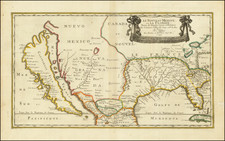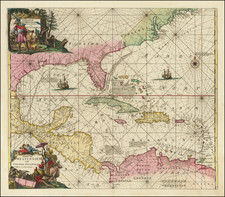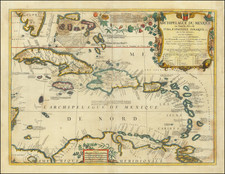Rare (Unrecorded?) South Florida Railroad Company Promotional Map with Manuscript Additions
Rare separately published map of the eastern portion of Florida, published by the South Florida Railroad Company in Sanford, Florida, in 1886, shortly after completion of its lines through to the Tampa area. On the verso, the map includes an extensive promotional tract, promoting the region serviced by the South Florida Railroad Company and offering land for sale in a number of southern counties.
The present map would seem to be the earliest printed map to illustrate the South Florida Railroad Company's designs on a railroad system extending to Tampa.
Colton's map is divided by into counties and townships. There are certain sections in the southern part of the State which are not yet subdivided into townships. Counties are outlined in green, yellow and pink. Other geographical entities include towns, lakes, rivers, bays, and coastal islands.
The map highlights the progress of the surveys of the General Land Office in Florida, now nearly completed except in the wetlands and swamps in the Lake Okeechobee region.
This example has been overprinted with information promoting the South Florida Land Company, whose lands are printed in a blue checkerboard pattern. The lines of the various railroads and steamships are identified in red (railroads) and dashed red lines (steamships).
The map has been augmented with a blue line running along the east coast of Florida from the St. Johns River and Pablo Creek, south to St Augustine, where it joins with a black line extending south to the Titusville area, and then onward through the Indian River to a point south of Ft. Pierce. The line is an apparent attempt to illustrate the Intercoastal waterway which would soon be commenced by a group led by John Westcott. There is also a massive section of Brevard County which has been augmented with pink shading, to the north of Lake Okeechobee.
Florida's Intercoastal Waterway in the 1880s
In 1881, a group of St. Augustine residents led by John D. Westcott established the Florida Coast Line Canal and Transportation Company (the FCL). The FCL obtained Florida's permission to dredge a series of canals to create an inland waterway along the length of Florida's Atlantic coast, in exchange for 3,840 acres of land for every mile of canal constructed. The FCL was also granted the right to collect tolls on the waterways.
In 1885, Floride deeded the FCL 87,670 acres of public lands. Dredging operations picked up considerably over the next five years moving south, and in 1890 the state deeded 345,972 acres to the FCL. That same year, the company sold over 1,300 acres to Duncan U. Fletcher, who deeded this land to his Florida Fiber Company to cultivate sisal hemp. In 1891-1892, the company had reached Jupiter and began to work southward to Lake Worth. In 1892, Henry Flagler invested in the firm and a year later became president for a brief time in order to expand his railway.
The system became known as the Atlantic Intracoastal Waterway, ultimately linking Jacksonville to Miami in 1912. The company and Flagler worked in tandem for a while, but also were in competition as both the railway and canal operations moved south. Between 1882 and 1912, the FCL constructed 268 miles of canals, thereby receiving title to over 1 million acres. Henry Flagler ended up with a quarter of this land for the Florida East Coast Railway extension to Miami in the 1890s.
South Florida Railroad Company
The South Florida Railroad was incorporated on October 16, 1878, but was unable to obtain a charter until December 9, 1879, when it took over the charter of the Lake Monroe and Orlando, whose charter allowed it to build from the St. Johns River port of Sanford south to Orlando. The South Florida first ran on November 11, 1880, running the short distance between Sanford and Orlando. However the company had plans to continue to the Gulf of Mexico, reaching it at Tampa.
On May 4, 1883, Henry B. Plant and his Plant System (headed by the Savannah, Florida and Western Railway) bought 60% of the stock of the South Florida after an unsuccessful attempt to buy the Florida Southern Railway. Plant had made an agreement with the Florida Southern not to build the SF&W south of Gainesville or Palatka, the northern ends of the Florida Southern, but the existing South Florida was immune from this. Plant then made agreements with all the railroads building towards Tampa except for the Florida Transit and Peninsular Railroad. Specifically, the Florida Southern would not build any lines south of Pemberton's Ferry and Brooksville or north of Bartow, and the South Florida would build its Pemberton Ferry Branch between the two and assign trackage rights to the Florida Southern.
The agreement with the Jacksonville, Tampa and Key West Railway specified that that company would only build north of Sanford; in both cases the South Florida would give up their rights to the territories given to the other companies. The JT&KW had already done some grading at Bartow and Tampa, and sold them to the South Florida.
Thus two railroads remained in a race towards Tampa - the South Florida and the Florida Transit and Peninsular Railroad. The South Florida managed to get there first, and obtained the best ports (now Port Tampa). The Tampa end opened on December 10, 1883, and on January 25, 1884 service began over the full line.
Rarity
While Colton's Sectional Map of the Eastern Portion of Florida was published for over a decade, this version of the map, overprinted to promote the South Florida Railroad Company, is apparently unrecorded.
G. W. & C. B. Colton was a prominent family firm of mapmakers who were leaders in the American map trade in the nineteenth century. The business was founded by Joseph Hutchins Colton (1800-1893) who bought copyrights to existing maps and oversaw their production. By the 1850s, their output had expanded to include original maps, guidebooks, atlases, and railroad maps. Joseph was succeeded by his sons, George Woolworth (1827-1901) and Charles B. Colton (1831-1916). The firm was renamed G. W. & C. B. Colton as a result. George is thought responsible for their best-known work, the General Atlas, originally published under that title in 1857. In 1898, the brothers merged their business and the firm became Colton, Ohman, & Co., which operated until 1901, when August R. Ohman took on the business alone and dropped the Colton name.












![(Colonial East Florida / St. Augustine to Cape Canaveral area) -- [Land Holdings of John Moultrie, Deputy Governor of East Florida] A Schedule and apprasement [sic] of the property of John Moultrie in East Florida which he is now in possession of and did possess at the time that province was ceded to the crown of Spain](https://storage.googleapis.com/raremaps/img/small/86619.jpg)



![Island of Cuba (Spanish) and Jamaica (British) [also South Florida, Bahamas and Cayman Islands]](https://storage.googleapis.com/raremaps/img/small/98323.jpg)